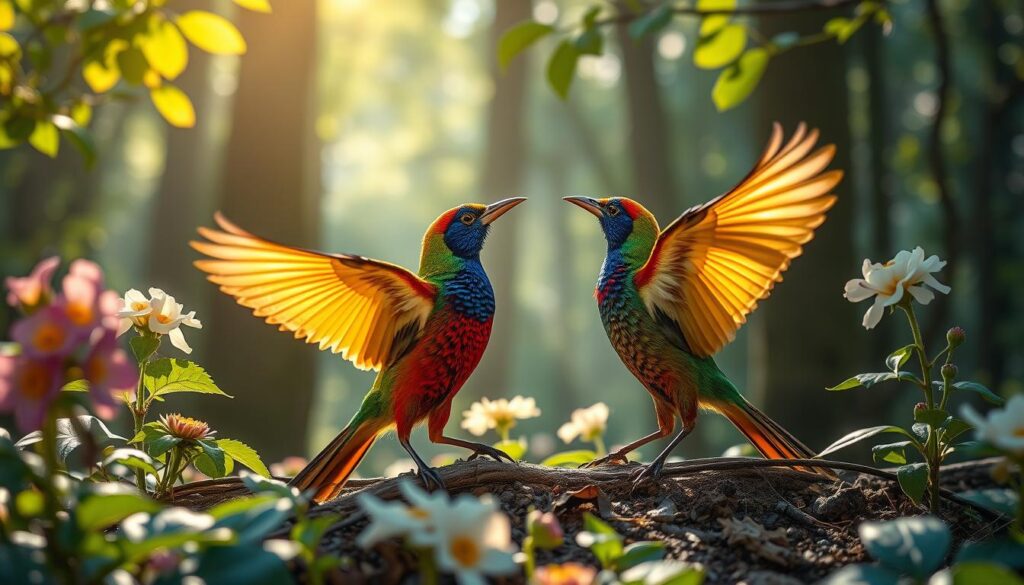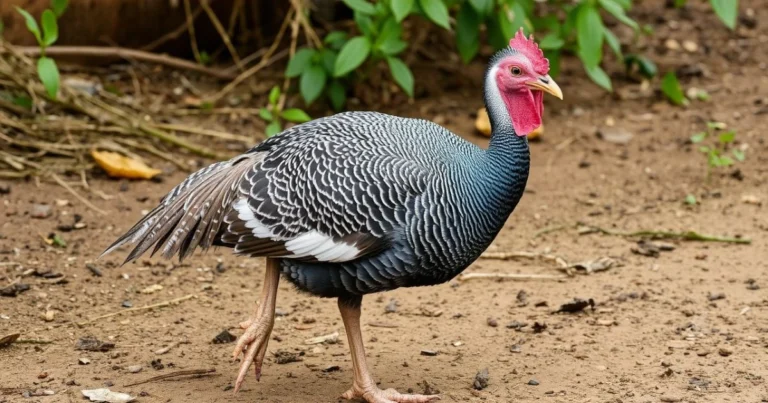The Process of Copulation in Birds
Ever wondered how birds mate? This article will take you on a fascinating journey into the world of bird mating. You’ll learn about their unique courtship rituals and how they reproduce. We’ll explore the anatomy and behaviors that help birds ensure their species continues.
Table of Contents
Bird Anatomy: Reproductive Organs
Birds have a unique way of reproducing compared to mammals. Both males and females have a cloaca, a special vent. It’s where sperm, eggs, feces, and urine come out. This setup helps in the exchange of genetic material during mating.
Cloaca: The Avian Multipurpose Vent
The cloaca is key to a bird’s reproductive system. It gets bigger during breeding season. This makes it easier for sperm to move from male to female. It also helps birds lay eggs and get rid of waste.
Male and Female Reproductive Anatomy
Male birds have two testes that make sperm. These organs change with the seasons, showing when it’s time to mate. Female birds have one ovary that makes eggs. These eggs get fertilized by the male’s sperm during mating.

About 97% of bird species don’t have a penis. They use the cloaca for reproduction. But, some birds like ducks and geese have a phallus for internal fertilization.
Things like pollution and habitat loss affect bird reproduction. Pesticides, light and noise pollution, and big changes in habitats can mess up their breeding cycles. These disruptions can harm their nesting behaviors.
Prelude to Mating: Bird Courtship
The journey to love for birds is filled with fascinating bird courtship behaviors and unique displays. They perform elaborate dances and sing beautiful bird songs. These avian courtship rituals help attract females, show off their health, and choose the right mate.
Dance of Love: Courtship Rituals
Behaviors like the Sage Grouse’s puffed-up displays and the Peacock’s stunning feathers have evolved over millions of years. These mating displays are a sight to behold. Birds show off with bowing, wing-flapping, and dances to impress their partners.
Colorful Courtship: Vibrant Plumage Displays
The bright colors and patterns of many birds are key in avian courtship rituals. They show off their health and genetic quality. These mating displays are enhanced by complex body movements and postures.
Serenading the Heart: Melodious Songs
Bird song is also crucial in courtship. Male birds sing to attract females, show their fitness, and defend their territories. Their songs range from trills to booming calls, essential for successful mating.
How Do Birds Mate: The Cloacal Kiss
Birds’ courtship rituals are captivating, but their mating process is surprisingly simple and unique. Since males don’t have a penis, they use the “cloacal kiss” to transfer sperm to females.
The cloacal kiss is a quick and delicate touch. It happens when the male mounts the female from behind. The female arches her back and moves her tail to the side. This allows their cloacae to touch briefly, transferring sperm and fertilizing the eggs.

The timing of the cloacal kiss is crucial for breeding success. Many bird species have specific mating seasons. This ensures their offspring have the best chance to survive.
This unique mating behavior shows nature’s incredible design. Birds use their cloaca for a streamlined reproductive system. This allows them to mate quickly and successfully, ensuring their species continues.
If you love birdwatching or just enjoy nature, learning about birds mating and the cloacal kiss is fascinating. It helps us appreciate the amazing adaptations of these creatures.
Are Birds Exclusive in Their Mating Habits?
Many bird species form pairs for a season, year, or a lifetime. But, this doesn’t mean they are always faithful. Birds may mate with different partners to ensure successful breeding. This can lead to chicks having different fathers.
Female birds can have sperm from multiple partners. They build similar nests, and a female may lay eggs in several nests. This means two birds might raise chicks that aren’t biologically related to them. Birds don’t see this as a problem. They form social bonds, not just sexual ones, living in “open-feather relationships.”
Open-Feather Relationships
While some bird species are monogamous, many are not. They engage in non-monogamous behaviors, like open relationships. This means they mate with multiple partners in one breeding season. Chicks can have different fathers.
The cloacal kiss, a common mating method, only allows a small percentage of sperm to reach the female. This means birds need to try multiple times to get fertilized.
| Mating Behavior | Examples |
|---|---|
| Monogamous | Swans, Geese, Cranes |
| Non-Monogamous | Ducks, Gulls, Songbirds |
The variety in bird mating habits shows their evolutionary adaptations and complex social lives. From monogamous to open-feather relationships, birds have many ways to ensure their species survives.
“Birds are understood to foster social bonds instead of purely sexual ones, essentially participating in ‘open-feather relationships.'”
How Do Birds Without Cloaca Mate?
Most birds mate through the cloacal kiss. But, ducks, swans, geese, and others have a special way. They have a penis, a part of their cloaca that stands up when they mate. This helps them mate better, especially since they do it in the water.
Waterfowl and Their Penises
Ducks and swans mate in the water. The male holds the female under the water to mate. This method is more effective than the cloacal kiss, helping them have more success.
Only 1-2% of sperm from a bird’s mate reaches the female’s body. But, waterfowl’s penises help them mate better. This means they have a higher chance of successful fertilization.
Female birds can keep sperm from different mates in their bodies. This increases their chances of getting pregnant. Some birds even have open-feather relationships. This means a female can lay eggs in different nests, leading to chicks with different dads.
Birds have many ways to mate, showing their amazing adaptations and intelligence. From the cloacal kiss to waterfowl’s penises, their mating behaviors are fascinating. They give us a peek into how these creatures survive and thrive.
Observing Bird Mating: A Warm Reminder
Watching birds mate is truly captivating. But, we must watch with care and respect. Birds focused on mating might not see us. If we disturb them, they might leave their nesting sites, harming their young.
To be a good observer, keep a safe distance and be quiet. Tools like the Bilantan Smart Bird Feeder with Camera let you see without interrupting. This way, you can see their courtship and mating without harming them.
Remember, observing birds mating is a special chance. By respecting bird mating and avoiding disturbing birds during mating, we help these amazing creatures. This ensures they can live and thrive in the wild.
“The best way to experience the beauty of nature is to observe it from a respectful distance, allowing the animals to thrive in their own rhythm.”
Bird mating is a delicate and short process. It’s our duty to protect these moments. By following these tips, you can enjoy bird mating while keeping the birds safe.
How Do Birds Reproduce
Birds have many ways to reproduce. They have special courtship rituals and unique ways of laying eggs and incubating them. These methods are fascinating and help their species survive.
The cloaca is a key part of bird reproduction. It’s a special vent that birds use for digestion, urination, and reproduction. When birds mate, they touch their cloacas, which helps transfer sperm.
Only a small part of the sperm from the male bird actually reaches the female. To boost their chances, some birds mate multiple times during the season.
Birds also have interesting courtship behaviors. They dance, show off their colors, and sing to attract mates. Some birds stay with one partner for life, while others change partners each season.
Egg-laying and incubation in birds are also unique. Some birds lay a set number of eggs, while others keep laying eggs without stopping. The time it takes to incubate eggs varies, from just 9 days to 80 days.
Parental care in birds is shared by both males and females. They alternate responsibilities for incubating the eggs and feeding their chicks. In some cases, birds even trick other birds into raising their chicks.
The world of bird reproduction is complex and full of amazing adaptations. By learning about these processes, we can better appreciate the beauty and strength of birds.
Conclusion
The world of bird mating and reproduction is truly fascinating. It’s filled with different strategies, behaviors, and unique adaptations. From the elaborate courtship displays to the special mating methods of waterfowl, each aspect is designed for success. By exploring bird mating, we learn to appreciate the amazing diversity and complexity of these creatures.
Watching birds or learning about their mating processes reminds us of nature’s wonders. The study of bird mating shows us the incredible ways birds adapt to thrive and spread their species. This journey into the avian mating world highlights the intricate details of nature.
Birds have evolved amazing reproductive strategies. From the low success rate of sperm reaching the female’s body to the unique mating methods of waterfowl, their ingenuity is clear. Understanding avian copulation and egg development helps us see the remarkable adaptations that allow birds to succeed in their habitats worldwide.







